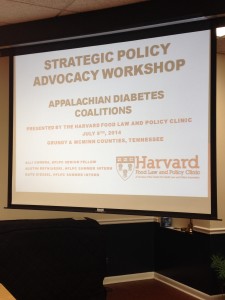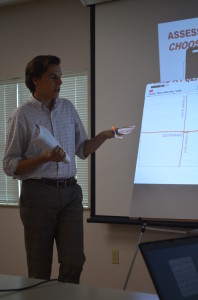by Austin Bryniarski*, Summer Intern, Harvard Food Law and Policy Clinic
I remember when I first learned about food deserts some years ago. I was at an urban farm in Milwaukee, minutes away from the city’s largest housing project, perplexed by the simultaneous cacophony of chickens and car alarms. To me, food access mainly concerned city dwellers. My understanding was basic: supermarkets planted themselves in middle-class neighborhoods, leaving low-income residents with precious few options for healthy and affordable food. In response to this alarming pattern, novelty ways of producing food — like urban agriculture — came to be.
Fast-forward to one week ago, four years after my food access amuse-bouche, and I’m presenting policy options to a group of people interested in increasing food access in their community. Unlike Milwaukee, though, the trains carried coal instead of people and the closest downtown was a couple of blocks long, at best. My supervisor, a fellow intern, and I traveled to Vanceburg, Kentucky and Athens, Tennessee to train community members in food policy advocacy and facilitate the creation of a food policy action plan. The focus of our presentations was to discuss ways to increase production and consumption of local agricultural products in rural Appalachia — a place stricken with food access issues that I admittedly, until this trip, had not thought a lot about.
Rural America is rife with food insecurity. Like urban food deserts, poverty severely affects Appalachia, which makes it harder for residents to afford healthy foods and more challenging for grocers to ensure they’ll have enough of a demand to supply. Upon our arrival, we found out that one of two grocery stores in Grundy County, Tennessee had recently closed. Without grocery stores, rural communities depend on corner stores and fast food restaurants for nourishment because they are convenient and inexpensive, albeit unhealthy. (An excursion to Cracker Barrel — the ubiquitous, kitschy restaurant at every highway exit — proved this. I still reminisce about my chicken-fried steak, all slathered with gravy.)
Geographic distance plays a role in rural food access, too — the USDA considers rural Census tracts food deserts if at least a third of the tract’s population is more than ten miles away from a grocery store. Grundy and McMinn Counties in Tennessee contain food deserts under this definition. Complicating this metric is the fact that some residents may not be able to drive — especially in areas with low vehicle access, no public transportation, or with large elderly populations — further limiting the options of where someone can purchase food. The USDA’s Food Access Research Atlas shows that almost half of Lewis County is considered a “low vehicle access” area. We constantly heard about how schools throughout the region had had only one day of school in January because inclement weather made travel unsafe; the same hazards can prevent many from going out for groceries, too.
The situation in Appalachia carries a subtle irony. We city slickers often picture rural America as where we get most of our food from, red barn and spotted cow and green tractor, and thus question why food access would persist in such a place. The numbers, however, tell a different story about the places we travelled. According to the 2012 Census of Agriculture (the food and farm policy wonk’s Bible), commodity crops like hay, corn, and soybeans dominate agricultural production in Kentucky and Tennessee, while income from fruit and vegetable production is at the wayside, clocking in at anywhere from 2 to 4 percent of all production. Further complicating our myth, farmers are shifting away from the profession: since the last Ag Census in 2007, the number of farms dropped by 10 and 14 percent and the total land in farms dropped by 7 and 1 percent in Kentucky and Tennessee, respectively. Fewer farmers are farming less land. And what they are farming isn’t ending up in salad bowls or soup pots nearby.
These twin problems of food access — lack of consumption and lack of production — can have significant impacts on public health. The Centers for Disease Control (CDC) has reported that Appalachia is home to the highest rates of obesity and diabetes in the country. The groups we presented to, called the “Appalachian Diabetes Coalitions” (ADCs), are part of a program created by Marshall University in West Virginia, and they exist throughout the region to respond to and improve public health outcomes associated with diet-related disease. The ADCs that we worked with identified the issues of agricultural production and local food consumption as major priorities, so our report focused on three strategies for improving each issue.

Alli discussing policy options over the lunch break in Tennessee.
To improve production, we focused on policies the ADCs could advocate for that would incentivize farmers to grow more fruits and vegetables. For example, we looked at policies that allocate greater funding toward new farmers or farmers transitioning to food production from a different crop, for example through grants, low-interest loans, or tax incentives. We also provided examples of policies that improve training for farmers (either new farmers or farmers learning how to comply with food safety regulations, for instance) and policies that could more innovatively link farmers to farmland (aptly called “land-linking”) that Kentucky or Tennessee could emulate.
To improve consumption of local, healthy food, we focused on how local producers could best take advantage of local markets. I presented about local procurement by institutions, where a state policy could require schools or state agencies to purchase local produce (thereby supporting the local economy). We also discussed policies to make direct-to-consumer purchasing easier (like placing EBT machines at farmers’ markets) and ways to improve the distribution in the supply chain, like incentivizing the existence of food hubs and food processing facilities.
After providing this menu of options and discussing how relevant each one would be in the counties we worked with came the “policy advocacy” activities that were well-received by the coalition members. For the time we had, we realized our original goal of unveiling a completed action plan by the end of the day was too ambitious, but we still went through the process that the ADCs will replicate on their own time after more carefully considering each component of their plans. We spent the afternoon evaluating policy goals, partners, and strategies for attaining those goals; defining what successful advocacy for that goal would look like; and anticipating challenges that would arise from advocating for a policy. With business cards exchanged and photos snapped, our workshops ended with an air of excitement and a palpable potential.

Kate Giessel, FLPC Summer Intern; Alli Condra, Senior Clinical Fellow, FLPC; and Austin Bryniarski, FLPC Summer Intern
It seems to me that the growing “food policy movement” has honed in on urban centers in recent years, mostly concerned with the wants and needs of people living in cities. Take farmers’ markets — policy has made setting up a farmers’ market in a cities around the U.S. easier, so that all it takes is a trip down the block to buy groceries directly from Farmer Brown. Everyone — from city and country — is happy. Right?
What about the rural folks living amongst those farmers? Where are they in the distribution chain, and how are they affected? When we talk about “improving sustainable agriculture,” which demographics are we improving it for? Appalachia made me realize that rural food politics are woefully uncharted, and in solving the problems of an interdigitated food system, rural food politics cannot be left out of the picture. While our interactions with the coalitions were limited to a two-day trip, the objective of our workshops was clear and started a conversation that would continue into the future. Equipping everyone — especially rural populations — with policy advocacy skills makes for a food system that is responsive to the needs and wants of all its consumers and producers.
Even so, rural and urban settings face different problems that will require different solutions — a lot of the examples we presented to the ADCs were city-centric, because that’s where a lot of food policy has been theorized and implemented. Bearing this in mind, we charged the groups to think of what bits and pieces might apply to their communities, even if Vanceburg, Kentucky looks entirely different from Milwaukee or Boston. We also clarified that our list was not exhaustive, because surely there are food policies we didn’t think of, or ones that do not yet exist. The gaps in rural food policy became clearer; if we are to have an inclusive and comprehensive movement, we’ve got to mind those gaps. I’m hopeful that the Appalachian Diabetes Coalitions we worked with are doing that. But it’s just as important for anyone who cares about food policy to be cognizant as well.
* Austin Bryniarski is a rising junior in Calhoun College majoring in Environmental Studies at Yale University. He is a Lazarus Global Food Fellow at the Yale Sustainable Food Project.
This post was originally published on the Yale Sustainable Food Project’s Tumblr site: http://ysfp.tumblr.com/post/92542815494/what-about-rural-food-policy-advocacy-in-appalachia.
————–
The views reflected in this blog are those of the individual authors and do not necessarily represent those of the Center for Health Law & Policy Innovation or Harvard Law School. This blog is solely informational in nature, and not intended as a substitute for competent legal advice from a licensed and retained attorney in your state or country.





Health Law & Policy, Commentary
Braidwood Management v. Becerra: Updated FAQs for Health Advocates and Providers
July 22, 2024